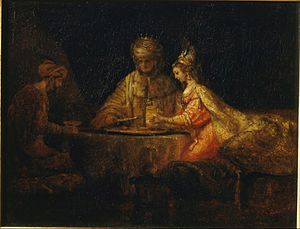Book of Esther facts for kids
| Old Testament (Tanakh) |
|---|
|
Old Testament Books of the Old Agreement common to all Christians and Jews)
Additional Books (common to Catholics and Orthodox)
Georgian Orthodox |
The Book of Esther is a fascinating story found in the Tanakh (the Hebrew Bible) and the Old Testament. It tells the tale of a brave young woman named Esther, who becomes a queen and saves her people. This book is also the reason behind the Jewish holiday called Purim, which is celebrated every year.
Contents
Who Wrote the Book of Esther?
It's a mystery! The book of Esther doesn't tell us who wrote it. But we can make some good guesses based on what's inside the story.
When Was the Book Written?
The author was likely a Jew because they really focused on the Jewish festival of Purim. They also seemed to know a lot about Persian customs. This suggests the author lived in a Persian city, not in Judah or Jerusalem. The story was probably written around 460 B.C., which was after the events in the book happened. The festival of Purim was likely already being celebrated when the book was put into writing.
What Is the Book of Esther About?
The main goal of the book of Esther is to explain how the yearly festival of Purim began. It also reminds people about how the Jewish people were saved during the time of King Xerxes. The book shows why this special celebration should continue to be remembered.
What Are the Main Ideas?
The story of Esther often talks about the struggle between good and evil. It shows how God's people faced challenges from those who wanted to harm them. Haman, a bad guy in the story, tried to get rid of all the Jews. But when he was defeated, the Jewish people found peace.
Feasting is another big idea in the book. There are many banquets, or big meals, in the story. These meals are important because they are where many key parts of the story happen. The book mentions ten different banquets!
How Is the Story Told?
The book of Esther uses a lot of repetition. This means some things happen more than once. For example, there are two sets of banquets, two lists of servants, and two times Esther kept her identity a secret. This repetition helps to make the story memorable.
One interesting thing about this book is that it never directly mentions God, prayer, or worship. Some people have wondered why. However, it might be that the author wanted to show that even without direct mentions, God was still in control. He was working behind the scenes, using small "coincidences" to save the Jewish people.
What Happens in the Story?
The Book of Esther tells the exciting story of a young Jewish girl. Her parents died, and her kind uncle, Mordecai, adopted her.
Esther Becomes Queen
The Persian King Xerxes had a queen named Vashti. But she refused to do what he asked, so he removed her from her position. The king then held a beauty contest to find a new queen. He fell in love with Esther and chose her! He didn't know that she was Jewish.
Haman's Evil Plan
Haman was King Xerxes' most important helper, like a prime minister. He became very angry with Mordecai because Mordecai would only bow down to God, not to Haman. Because Mordecai was Jewish, Haman decided to try and trick the king. He wanted the king to make a law to kill all Jewish people in the kingdom. Haman didn't know that Queen Esther was also Jewish.
Esther's Courage Saves Her People
Queen Esther soon found out about Haman's terrible plan. She knew she had to stop it. She bravely invited the king and Haman to a special dinner. At first, she was too scared to tell the king about Haman's plot.
So, she invited them to another dinner. This time, she found her courage and told King Xerxes everything about Haman's evil plan. The king was furious! He ordered Haman to be hanged on the very gallows that Haman had built for Mordecai.
In the end, because of Esther's bravery and influence, the king changed the law. This saved the Jewish people from Haman's wicked plot.
Images for kids
-
A 13th/14th-century scroll of the Book of Esther from Fez, Morocco, held at the Musée du quai Branly in Paris. Traditionally, a scroll of Esther is given only one roller, fixed to its lefthand side, rather than the two used for a Torah scroll.
-
Esther is crowned in this 1860 woodcut by Julius Schnorr von Karolsfeld.
-
The Feast of Esther (Feest van Esther, 1625) by Jan Lievens, North Carolina Museum of Art.
See also
 In Spanish: Libro de Ester para niños
In Spanish: Libro de Ester para niños








